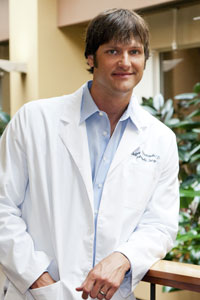Biceps Tendon Injury Specialist

Are you an athlete who participates in sports that involve heavy overhead lifting? If so, you may be at risk of tearing your biceps tendon. A biceps tear can occur from repetitive overuse, a fall, heavy lifting or degeneration of the tendon over time. Biceps tendon injury specialist, Dr. Jeff Padalecki provides diagnosis and both surgical and nonsurgical treatment options for patients in Austin who have suffered a biceps tendon injury. Contact Dr. Padalecki’s team today!
Biceps Tendon Injury Overview
The biceps muscle is located at the front of the arm and has an important function in flexing the elbow and rotating the wrist. The upper part of the bicep muscle is attached to the shoulder with two tendons – the long head and short head. The long head tendon attaches directly to the labrum and passes inside the shoulder joint itself. Because the long head tendon passes into the shoulder joint, it is susceptible to injury and can be a common cause of shoulder pain. The lower part of the bicep muscle is attached to the forearm with a single tendon and this can also tear or be the source of pain in the elbow. A biceps tendon tear can happen at either the shoulder or the elbow. These tendons may fray or eventually tear at their attachment sites from chronic overuse or extreme heavy lifting. There are two classifications of tears: complete or partial. In a complete tear, the tendon will tear completely away from the bone. Shoulder specialist, Dr. Jeff Padalecki, serving patients in Austin, Round Rock, and Cedar Park, Texas and surrounding communities, helps patients return to activities following a biceps tendon injury.
What are the Symptoms of a Biceps Tendon Injury?
The most obvious symptom associated with a biceps tendon tear will be a sudden and severe pain depending on where the tendon is injured. Some patients will hear or feel a “pop” when a tendon tears. Other symptoms include weakness in the shoulder or elbow, trouble rotating the arm, a change in the appearance in the front of the arm; a bulge due to the fact that the tendon is no longer holding the muscle in place.
Biceps Tendon Injury Diagnostics
If a torn biceps tendon is believed to be the injury at hand, Dr. Padalecki will most likely order an MRI. Because these injuries are often associated with heavy lifting, a physical exam will usually provide the evidence of the tear, with the MRI confirming the diagnosis.

What is the Treatment for a Biceps Tendon Injury?
Non-Surgical
Initially, a biceps tendon injury that involves a partial or minor tear can be treated with rest, ice, and anti-inflammatory medications. Patients are encouraged to avoid any heavy lifting and undergo a course of physical therapy to gain back the strength and flexibility lost with the injury.
Surgical
The need to surgically repair a bicep tendon injury depends upon your age, activity level, and the severity of your injury as well as if the injury fails to respond to the non-surgical treatment. Tears of the distal tendon, which attaches to the radius, almost always require surgical repair.
A torn bicep tendon in the shoulder can be repaired with minor incisions, with the end result of re-anchoring the torn tendon back to the bone. If only a small portion of the tendon is damaged, a simple shaving (debridement) of the torn fibers may be all that is needed. If a significant portion is involved, a biceps tenodesis may need to be performed by removing the torn tendon stump from inside the shoulder joint and then attaching the remaining tendon to the bone in the upper arm (humerus).
Post-Op Instructions
Following surgical repair, physical therapy will be prescribed to return the patient to optimum function. It’s important for patients to work with Dr. Padalecki in their recovery and follow the prescribed rehabilitation guidelines as set forth by him. Following a biceps tendon repair, most patients are able to resume normal activities within several months.
For more information on a biceps tendon injury, such as a biceps tendon tear, please contact the office of Dr. Jeff Padalecki, Austin, Texas orthopedic shoulder specialist.